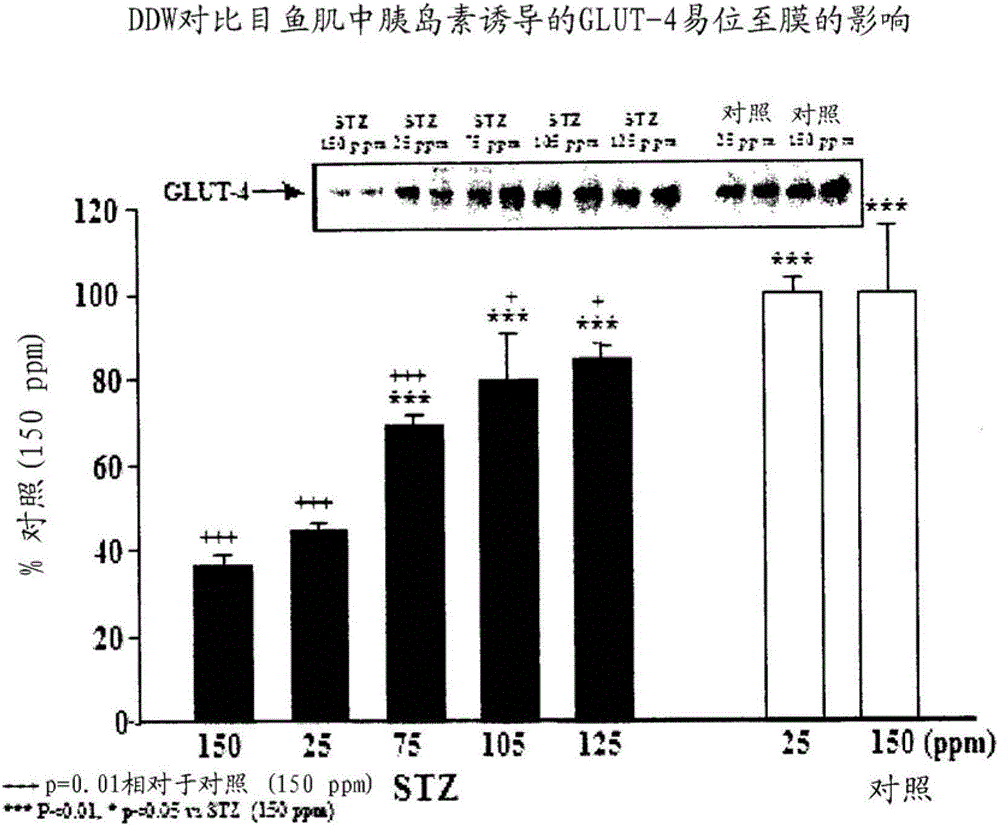Use of deuterium depleted water for the treatment of insulin resistance
A technology of insulin resistance and deuterium-depleted water, which is applied in the fields of carbohydrate active ingredients, medical preparations containing active ingredients, food science, etc., can solve problems such as DDW treatment of insulin resistance, etc.
- Summary
- Abstract
- Description
- Claims
- Application Information
AI Technical Summary
Problems solved by technology
Method used
Image
Examples
preparation example Construction
[0040] The preparation of pharmaceutical products is carried out by methods standard in the art by mixing the active agent with an inert, inorganic or organic carrier and then preparing a galenical form from this mixture. A practical carrier is water.
[0041] The drug product may also contain other auxiliary components commonly used in the pharmaceutical industry (such as wetting agents, sweetening or flavoring agents, buffer solutions).
[0042] The daily dosage of the medicine according to the present invention can be varied and depends on various factors, such as the D concentration of the water, the age and weight of the patient, the type and severity of diabetes, and the like. For a 70 kg patient, the daily oral dose may be 0.01-2L DDW with a D concentration of 0.01-135 ppm. To enhance organoleptic properties and biological effects, the water may contain eg 20-30 g / L low D carbohydrates, certain low D amino acids or other flavors and fragrances.
[0043] The advantages...
Embodiment
[0051] Below illustrate the present invention with more detailed content, rather than limit protection scope:
[0052] A) Pharmacological Examples
[0053] In a rat model system, streptozotocin (STZ)-pretreated animals were treated with water with different deuterium concentrations for 4 weeks in several independent experiments. Rats received insulin treatment of 1 IU twice a day, the control group consumed normal water (150 ppm), while the treated groups consumed DDW at 25, 70, 105, 125, 130, 135, 140 and 145 ppm D levels. To find out what mechanism is responsible for the lower blood glucose levels in rats drinking DDW, the amount of GLUT4 protein in rat muscle cell membranes was determined. figure 1 The two rightmost blank bars in , show that in rats not pretreated with STZ, the amount of GLUT4 was not affected by the D concentration (25-150 ppm) of the water they consumed. The five dark bars on the left side of the figure show that in STZ-pretreated rats, the lowest GLUT4...
Embodiment 1
[0055] Formulation Example 1: Preparation of Drinking Water with Beneficial Mineral Composition
[0056] Mix low D water with mineral water of known composition (such as "Csillaghegyi" or "Balfi") in the following proportions:
[0057] a / 0.25 parts 90ppm DDW + 0.75 parts mineral water by volume (final D concentration: 135ppm);
[0058] b / 0.5 parts 90ppm DDW + 0.5 parts mineral water by volume (final D concentration: 120ppm);
[0059] c / 0.75 parts 90ppm DDW + 0.25 parts mineral water by volume (final D concentration: 105ppm);
[0060] d / 0.25 parts by volume 60ppm DDW + 0.75 parts mineral water (final D concentration: 127.5ppm);
[0061] e / 0.5 parts by volume 60ppm DDW + 0.5 parts mineral water (final D concentration: 105ppm);
PUM
 Login to View More
Login to View More Abstract
Description
Claims
Application Information
 Login to View More
Login to View More - R&D
- Intellectual Property
- Life Sciences
- Materials
- Tech Scout
- Unparalleled Data Quality
- Higher Quality Content
- 60% Fewer Hallucinations
Browse by: Latest US Patents, China's latest patents, Technical Efficacy Thesaurus, Application Domain, Technology Topic, Popular Technical Reports.
© 2025 PatSnap. All rights reserved.Legal|Privacy policy|Modern Slavery Act Transparency Statement|Sitemap|About US| Contact US: help@patsnap.com

